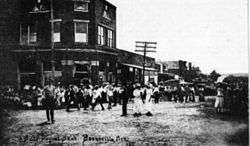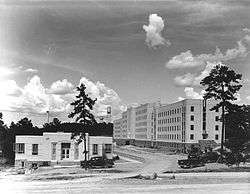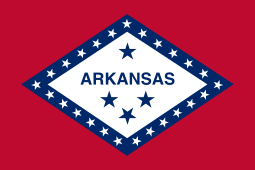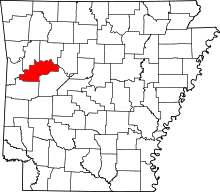Booneville, Arkansas
| Booneville, Arkansas | |
|---|---|
| City | |
|
Logan County Courthouse, Southern District in downtown Booneville | |
 Location in Logan County and the state of Arkansas | |
| Coordinates: 35°8′23″N 93°55′17″W / 35.13972°N 93.92139°WCoordinates: 35°8′23″N 93°55′17″W / 35.13972°N 93.92139°W | |
| Country | United States |
| State | Arkansas |
| County | Logan |
| Incorporated | 1878, 1899 |
| Area | |
| • Total | 4.1 sq mi (10.6 km2) |
| • Land | 4.1 sq mi (10.6 km2) |
| • Water | 0 sq mi (0 km2) |
| Elevation | 502 ft (153 m) |
| Population (2010) | |
| • Total | 3,990 |
| • Density | 995.6/sq mi (385.1/km2) |
| Time zone | Central (CST) (UTC-6) |
| • Summer (DST) | CDT (UTC-5) |
| ZIP code | 72927 |
| Area code(s) | 479 |
| FIPS code | 05-07720 |
| GNIS feature ID | 0062143 |
Booneville is a city in Logan County, Arkansas and the county seat of the southern district.[1] Located in the Arkansas River Valley between the Ouachita and Ozark Mountains, the city is one of the oldest in western Arkansas. The city's economy was first based upon the railroad and Arkansas State Tuberculosis Sanatorium, but has evolved into a diverse economy of small businesses and light industry as the early drivers have disappeared. Booneville's population was 3,990 at the 2010 census.
Booneville supports a community center, a senior citizens center, a community hospital, a municipal airport and new school facilities. Hunting, fishing, camping, hiking and other outdoors activities are readily available in nearby national forests and state parks.
History

Naming
The city was founded in 1828 when Walter Cauthron, an early explorer of the Arkansas Territory, built a log cabin and store along the Petit Jean River. Intending to name the community "Bonneville" for friend Benjamin Bonneville, the name was later changed. Another theory is that the name was to honor Daniel Boone, a friend of the Logan family for which the county is named.[2]
State Tuberculosis Sanatorium

The Arkansas State Tuberculosis Sanatorium was established in 1909 about three miles (5 km) south of Booneville. Once fully established, the sanatorium was the relocation center for all white Arkansans with tuberculosis. By the time the facility was closed in 1973, it had treated over 70,000 patients. The main hospital, named the Nyberg Building after Leo E. Nyberg, a former sanatorium patient and state legislator who sponsored the bill funding the construction, was completed in 1941. The facility became known worldwide as one of the most successful and modern hospitals for the treatment of tuberculosis of its day.
The sanatorium complex was self-sustaining, with dormitories, staff entertainment buildings, a chapel, laundry, dairy, water treatment plant, independent telephone system, and even a fire department. At the height of its use, the complex employed nearly 300 staff members. At one point, the total population of the center was greater than that of Booneville, in the valley below.
With the introduction of more effective drug therapy, the patient population began to decline. Eventually the sanatorium was closed in 1973. The campus is currently used as the Booneville Human Development Center, a state-run residential program for adults with mild and moderate intellectual disability and other developmental disabilities.
2008 Explosion of Meat Packing Plant
On March 23, 2008, Easter Sunday, a series of explosions destroyed the Cargill Meat Solutions plant, which employed approximately 800 people, making it by far the town's largest employer. Cargill exploded when 88,000 pounds of anhydrous ammonia and 100,000 pounds of carbon dioxide were ignited by sparks from a welder, causing the evacuation of at least 1,000 of Booneville’s roughly 4,000 residents, and leaving nearly 800 people without a job. Because of this tragic event, the town’s population drastically dropped in size and went into what many people began calling the “small-town recession.” On May 2, 2008 Cargill announced that the plant would not be rebuilt.[3]
Geography
Booneville is located at 35°8′23″N 93°55′17″W / 35.13972°N 93.92139°W (35.139650, -93.921272).[4] According to the United States Census Bureau, the city has a total area of 4.1 square miles (11 km2), all of it land.
Booneville is near Blue Mountain Lake, a lake popular for fishing, boating and swimming. Five United States Army Corps of Engineers (USACE) recreation areas are available for public lake access. At the east end of the lake, the Blue Mountain Wildlife Demonstration Area is a world-class bird dog field area. This area also hosts visitors interested in hiking, birding and mountain bike riding.
Demographics
| Historical population | |||
|---|---|---|---|
| Census | Pop. | %± | |
| 1880 | 275 | — | |
| 1890 | 496 | 80.4% | |
| 1900 | 988 | 99.2% | |
| 1910 | 1,631 | 65.1% | |
| 1920 | 2,199 | 34.8% | |
| 1930 | 2,099 | −4.5% | |
| 1940 | 2,324 | 10.7% | |
| 1950 | 2,433 | 4.7% | |
| 1960 | 2,690 | 10.6% | |
| 1970 | 3,239 | 20.4% | |
| 1980 | 3,718 | 14.8% | |
| 1990 | 3,804 | 2.3% | |
| 2000 | 4,117 | 8.2% | |
| 2010 | 3,990 | −3.1% | |
| Est. 2015 | 3,888 | [5] | −2.6% |
2014 Estimate[7] | |||
As of the census[8] of 2000, there were 4,117 people, 1,619 households, and 1,109 families residing in the city. The population density was 1,010.0 people per square mile (389.6/km²). There were 1,863 housing units at an average density of 457.0 per square mile (176.3/km²). The racial makeup of the city was 96.62% White, 0.05% Black or African American, 1.12% Native American, 0.27% Asian, 0.05% Pacific Islander, 0.17% from other races, and 1.72% from two or more races. 0.87% of the population were Hispanic or Latino of any race.
There were 1,619 households out of which 34.8% had children under the age of 18 living with them, 51.3% were married couples living together, 13.3% had a female householder with no husband present, and 31.5% were non-families. 28.5% of all households were made up of individuals and 16.2% had someone living alone who was 65 years of age or older. The average household size was 2.48 and the average family size was 3.01.
In the city the population was spread out with 28.0% under the age of 18, 8.1% from 18 to 24, 26.4% from 25 to 44, 20.0% from 45 to 64, and 17.5% who were 65 years of age or older. The median age was 36 years. For every 100 females there were 88.9 males. For every 100 females age 18 and over, there were 82.1 males.
The median income for a household in the city was $26,627, and the median income for a family was $31,012. Males had a median income of $25,238 versus $20,092 for females. The per capita income for the city was $13,076. About 13.1% of families and 18.4% of the population were below the poverty line, including 22.0% of those under age 18 and 23.9% of those age 65 or over.
Education

From its early days, Booneville has supported education. In 1874, as a response to needs for higher learning in western Arkansas, the Fort Smith District of the Methodist Episcopal Church, South, authorized the establishment of the Fort Smith District High School in Booneville, forty miles to the west. Local church members donated the land, building materials and labor. The school, located on South College Street, was to be supported by student tuition fees. Students came from towns all over western Arkansas to board with Booneville families and attend a school that offered an advanced curriculum, including Latin, German, advanced mathematics, literature and music. The school functioned until the early 1900s.
After the school closed, a group of residents and business leaders formed the Booneville Education Association and acquired 9 acres (36,000 m2) of land in the northwest part of town. The new school was called the Booneville Co-Educational Institute and also offered a more advanced curriculum than the public school around. Graduates were admitted as sophomores at the University of Arkansas at Fayetteville. In 1920, state funds were made available for the support of public high schools and the school's property was transferred to the Booneville School District. The building continued to be used as the city's high school until a new building was built in 1929. The old Co-Educational Institute building was used as the Booneville elementary school for several decades after that.[9]
Infrastructure
Transportation
The city is located at the intersection of Highway 23 (commonly known as "The Pig Trail") and Highway 10. Both routes are designated as Arkansas Scenic Byways near Booneville. Highway 217 also runs north and south from the city.
Rights of way for downtown city streets dedicated during the original town plat are wider than in most communities.
Water/Wastewater
The City of Booneville contains the Booneville Water Department. This department treats and distributes potable water from Lake Booneville to the residents and commercial users of the city in accordance with Arkansas Department of Health (ADH) regulations.[10]
The Booneville Water Department also collects and treats wastewater in accordance with a Clean Water Act National Pollutant Discharge Elimination System (NPDES) permit issued and administrated by the Arkansas Department of Environmental Quality (ADEQ).[11] Wastewater is collected and conveyed via gravity sewers and six lift stations to the Booneville Wastewater Treatment Plant (WWTP). Influent wastewater is received and flow rate is measured using a Parshall flume. Following measurement, wastewater passes through a fine screen into a pump station where it is lifted to a higher aerated degritter. It then enters the aeration basin for treatment, followed by a chlorine contact chamber, another flow meter and cascade aeration prior to discharge. Wasted Activated Sludge (WAS) is sent from the aeration basin to sludge lagoons, then to drying beds. A flow equalization basin is adjacent to artificial wetlands onsite.[12]
Treated effluent is discharged to Booneville Creek, ultimately draining to the Arkansas River.[11]
Notable natives
- Dizzy Dean and Daffy Dean - Major League Baseball players and brothers, born in the small community of Lucas, outside of Booneville.
- Kimberly Foster - American television and movie actor, best known for her role as Michelle Stevens in the later seasons of the prime-time soap opera Dallas.
- Elizabeth Ward Gracen - Former Miss America and an actress on Highlander: The Series.
- Tom Greenway - Character actor in numerous TV series of the 1950s and 60s such as Gunsmoke, Bonanza, Dragnet and Perry Mason.
- John P. McConnell - Chief of Staff of the United States Air Force from February 1, 1965 to July 31, 1969.
- Floyd Speer - Pitcher for the Chicago White Sox. Played in the Majors from April 25, 1943 to May 3, 1944. He is buried in the Carolan Community Cemetery.
- Aaron Lee Ward - Former infielder for the New York Yankees.
- Paul X. Williams - U.S. Federal Judge for the Western District of Arkansas, appointed by President Lyndon B. Johnson.
- Trey Holloway - Drafted by Detroit Tigers. Played baseball for U of A Razorbacks. Pitched in College World Series in 2004.
See also
-
 Arkansas portal
Arkansas portal
References
- ↑ "Find a County". National Association of Counties. Archived from the original on 2011-05-31. Retrieved 2011-06-07.
- ↑ Curry, Patricia L. (October 24, 2011). "Booneville (Logan County)". Encyclopedia of Arkansas History and Culture. Butler Center for Arkansas Studies at the Central Arkansas Library System. Retrieved March 14, 2015.
- ↑ Cargill Meat Solutions: Cargill will not rebuild in Booneville, Ark.
- ↑ "US Gazetteer files: 2010, 2000, and 1990". United States Census Bureau. 2011-02-12. Retrieved 2011-04-23.
- ↑ "Annual Estimates of the Resident Population for Incorporated Places: April 1, 2010 to July 1, 2015". Retrieved July 2, 2016.
- ↑ "Census of Population and Housing". Census.gov. Archived from the original on May 11, 2015. Retrieved June 4, 2015.
- ↑ "Annual Estimates of the Resident Population for Incorporated Places: April 1, 2010 to July 1, 2014". Retrieved June 4, 2015.
- ↑ "American FactFinder". United States Census Bureau. Archived from the original on 2013-09-11. Retrieved 2008-01-31.
- ↑ Booneville Democrat, Special Edition, June 30, 1999, Pg. 13
- ↑ "Booneville Water Department" (PDF). Annual Drinking Water Quality Report. ADH. 2013. Retrieved March 14, 2015.
- 1 2 "Authorization to Discharge Wastewater Under the National Pollutant Discharge Elimination System and the Arkansas Water and Air Pollution Control Act". NPDES Permit AR-0021571. ADEQ. April 23, 2013.
- ↑ "Process Flow Diagram" (PDF). ADEQ. Retrieved March 14, 2015.
External links
- Arkansas State Tuberculosis Sanatorium Historic Site
- Booneville Democrat -- Local Weekly Newspaper (On-Line Version)
- "Every Day Was Tuesday" The Arkansas TB Sanatorium
